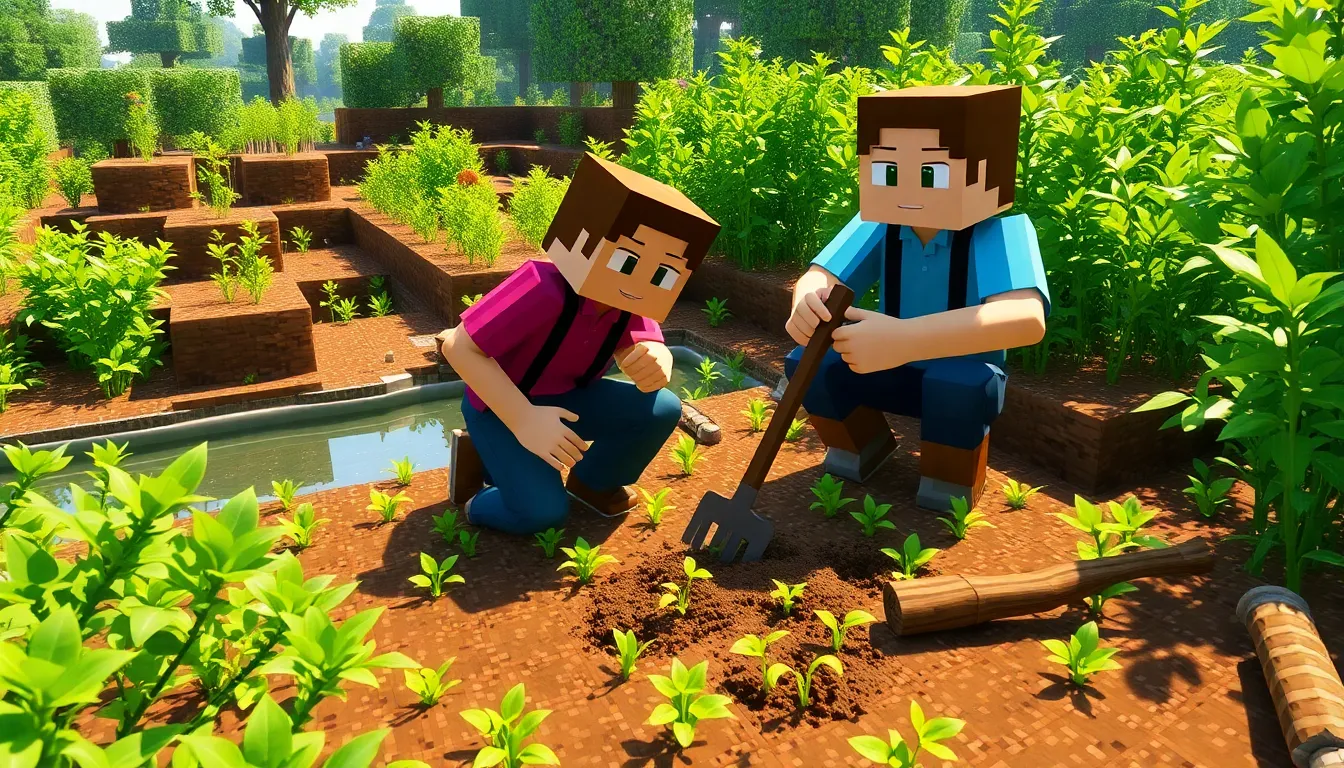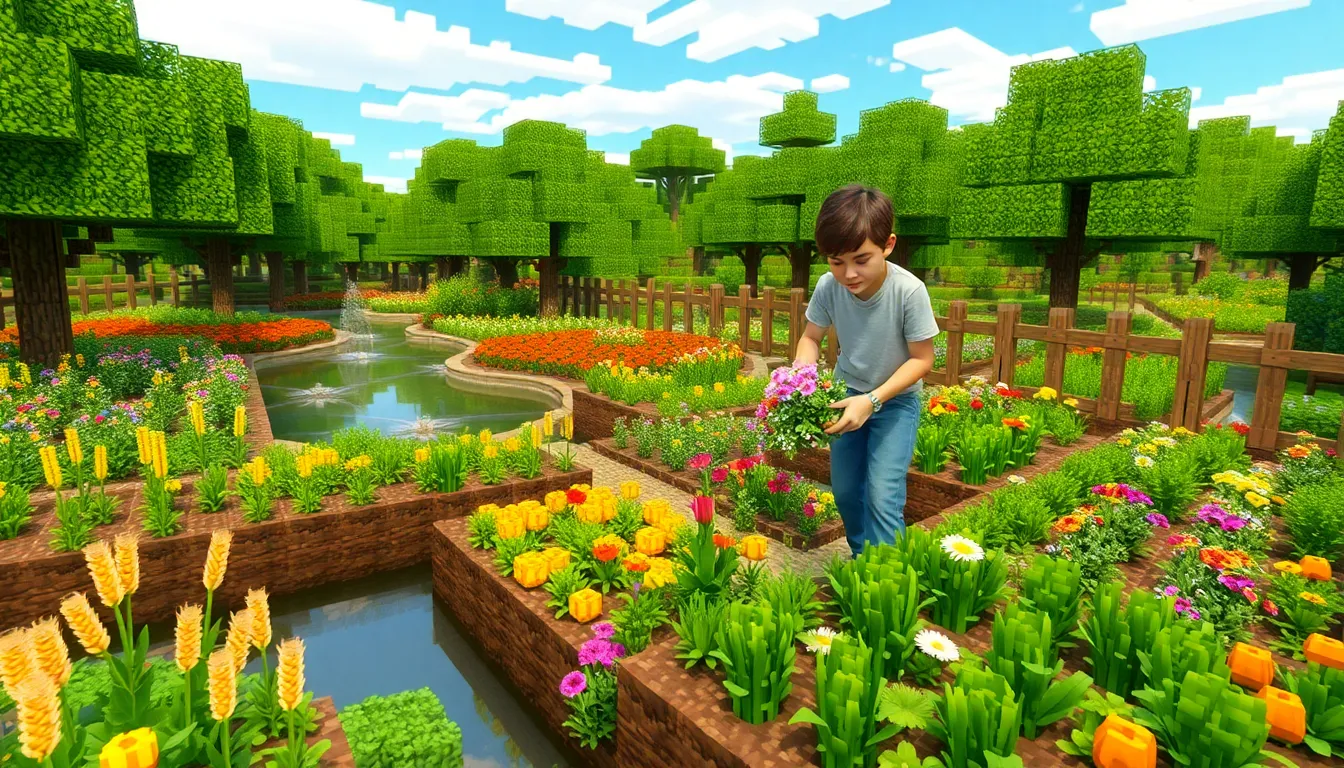Table of Contents
ToggleIn the pixelated world of Minecraft, players can unleash their creativity in countless ways, and gardening is one of the most delightful. Imagine transforming a barren landscape into a lush paradise filled with vibrant flowers and towering crops. It’s not just about survival; it’s about style. Who wouldn’t want to show off their green thumb in a world where everything’s made of blocks?
Overview of Minecraft Gardening
Minecraft gardening encompasses a wide range of activities that allow players to cultivate plants and create stunning landscapes. Players can grow various crops, including wheat, carrots, potatoes, and beetroot, providing essential food sources. Utilizing bone meal accelerates growth, enhancing efficiency in farming practices.
Flowers add colorful elements to gardens. Players can find different flower types across biomes, such as poppies, dandelions, and sunflowers. Each flower variety contributes unique aesthetics to landscapes, allowing for personal artistic expression.
In addition to crops and flowers, trees serve as vital components in Minecraft gardening. Players can plant saplings from various tree types, such as oak, birch, and spruce. Trees provide resources like wood, apples, and shade, further enriching the environment.
Water sources play a crucial role in gardening. Irrigating crops with water enhances their growth, as players can plant crops within a four-block radius from water. Designing efficient layouts that incorporate both plants and water sources maximizes yield.
Fences and paths enhance the garden’s functionality. Players often design intricate structures that not only organize gardening spaces but also protect crops from animals. Pathways made from gravel, cobblestone, or wood create an inviting atmosphere.
Redstone technology offers advanced gardening options. Players can automate certain gardening tasks, such as harvesting and replanting crops, using simple contraptions. This aspect showcases the blend of creativity and engineering in Minecraft gardening.
Ultimately, gardening in Minecraft empowers players to innovate and personalize their environments, transforming the landscape into a vibrant display of nature and creativity.
Getting Started with Minecraft Gardening

Gardening in Minecraft starts with selecting the ideal environment. Players can transform their surroundings into lush landscapes by making informed choices about location and tools.
Choosing the Right Location
A suitable garden location influences growth and aesthetics. Flat areas near water sources enhance accessibility for irrigation and crop expansion. Players often prefer biomes rich in sunlight, as ample light helps crops thrive. Opting for locations with minimal obstructions enables efficient layouts. Proximity to resources like trees offers easy access to wood and crafting materials. Fertile soil enables optimal crop growth, ensuring players maximize their yield.
Essential Tools for Gardening
Various tools enhance gardening efficiency in Minecraft. A hoe is vital for tilling soil and preparing plots for planting. Players utilize shovels for removing unwanted blocks, creating space for gardens. Buckets serve to transport water, ensuring crops receive necessary hydration. Bone meal acts as a fertilizer, significantly speeding up growth. Axes help manage trees, providing wood for constructing fences and pathways. Checks on inventory management also ensure players have sufficient tools for ongoing gardening projects.
Types of Plants and Crops
Minecraft features a variety of plants and crops that enhance creativity and gameplay. Players can cultivate colorful flowers and essential food sources, combining aesthetics with practicality.
Flowers and Decorative Plants
Flowers play a significant role in Minecraft gardening. They add vibrant colors to landscapes and offer players a chance to express their artistic flair. Common varieties include daisies, poppies, and tulips, found across different biomes. Planting flowers near farms or pathways creates visually appealing areas, while using bone meal on them promotes faster growth. Additionally, players can create unique arrangements, making their gardens stand out.
Farmable Crops
Players can grow multiple types of farmable crops, each providing vital food sources for survival. Wheat, carrots, potatoes, and beetroot constitute the primary crops. These crops grow in tilled soil and require water for optimal yields. Harvesting crops enables players to craft various foods or feed livestock. Efficient planting in rows maximizes space, while rotation ensures sustained growth and resourcefulness. Collecting and replanting crops creates a sustainable cycle, benefiting gameplay and survival efforts.
Gardening Techniques and Tips
Gardening in Minecraft involves various techniques for optimal plant growth and resource management. Players can utilize methods that enhance efficiency and maximize space.
Efficient Farming Methods
Implementing crop rotation benefits soil quality and increases yields. Planting fast-growing crops such as wheat alongside slower-growing ones ensures continuous harvests. Utilizing bone meal accelerates the growth process, allowing players to gather resources quickly. Additionally, using water canals improves irrigation, resulting in healthier crops. Automated farms, powered by Redstone, enable efficient collection and replanting, minimizing player effort while maximizing output.
Managing Space and Resources
Organizing gardening spaces plays a pivotal role in maximizing productivity. Players should prioritize planting crops in rows or grids, allowing for easy access and movement. Fencing not only organizes spaces but also protects crops from wandering animals. Incorporating trees alongside crops provides shade and additional resources, while strategically placed pathways enhance mobility. Using shovels to create designated areas ensures efficient use of available resources, leading to a more sustainable gardening experience.
Advanced Gardening Features
Advanced features in Minecraft gardening enhance creativity and efficiency. Players can explore automation and crossbreeding to elevate their gardening experience.
Automation with Redstone
Redstone offers powerful options for automating gardening tasks. Players can design systems that automatically harvest crops when they reach maturity. Using pistons, players push crops into designated areas for easy collection. Efficient layouts, combined with Redstone circuits, simplify tasks like planting and replanting seeds. Leveraging dispensers with bone meal also accelerates plant growth. Automated farms not only save time but ensure consistent crop production. Ultimately, simplified systems allow players to focus on design and aesthetics without sacrificing resource management.
Crossbreeding Plants
Crossbreeding opens up new possibilities for unique plant varieties. Players can create hybrid flowers by planting different types next to each other. Certain combinations yield new colors and traits, enhancing landscape diversity. Understanding the mechanics behind pollination aids in achieving desired outcomes. Observing which plants crossbreed successfully expands player creativity. More variety in flower colors and patterns can lead to aesthetically pleasing gardens. Experimenting with crop combinations can also yield greater yields for practical uses. Each successful hybrid adds more character to the Minecraft world and personal gardens.
Gardening in Minecraft opens up a world of creativity and innovation. Players can transform barren landscapes into lush gardens filled with vibrant flowers and essential crops. This unique aspect of gameplay not only enhances survival but also allows for personal expression.
By mastering techniques like crop rotation and utilizing automation, players can create efficient and visually stunning gardens. The interplay of aesthetics and practicality makes gardening a rewarding experience.
With endless possibilities for customization and design, Minecraft gardening encourages players to explore their creativity while cultivating their own unique slice of the blocky world.





